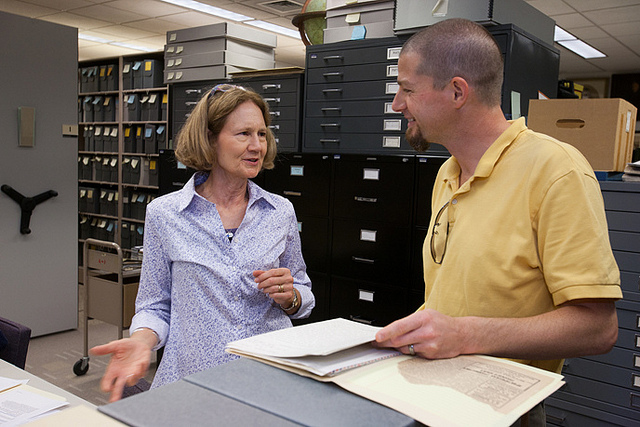Karl Qualls of Dickinson’s History Department reflects on plans to use digital tools in the teaching of Russian history and sustainability (re-blogged with minor edits from Teaching History)
Gleb Tsipursky of Ohio State University has advocated for the value of “class-sourcing,” that is, class assignments where students build websites, Pinterest boards, wikis, blogs, videos, podcasts, and other digital artifacts aimed at informing a broad audience about a specific subject. In this post I would like to introduce how I have adapted Gleb’s project to my Soviet history course (Russia: Quest for the Modern, History 254) at Dickinson.

Gail Troussoff Marks (’73) and Karl Qualls, associate professor of history at Dickinson College, look over documents that Marks has contributed to the Dickinson archives. source: Dickinson College flickr http://bit.ly/16UZXd0
Dickinson College has long been known for fostering global education and study abroad. More recently, we have taken up the call to teach our students and ourselves to be better stewards through the study and practice of sustainability. To this end, many faculty have been creating and reworking, to varying degrees, courses to highlight issues of sustainability in our fields. Given that most definitions of sustainability include not only environmental concerns, but also issues of human rights, access to political and economic power, and maintenance of cultures, the study of the Soviet Union seemed a logical course with which to begin.
Following Gleb’s lead, I have changed assignments in this course from a traditional research paper to a series of projects that will support students’ use of and contribution to our digitized knowledge base. In a series of steps, students will accumulate a bibliography on their topics, modify and annotate the bibliography, collect digitized sources (e.g. films, maps, timelines, photographs, etc.) that will help them tell a story, and then construct a lengthy multimedia blog post that will educate the broader public on their topics. Notes and bibliographies will be collected using Evernote so that students can easily sync their work between tablets and computers. Students will then share these Evernote assignments with classmates for peer review and with the wider world via the Twitter hashtag #h254 (after the course number) and other social media. Final projects will be posted to our blog in December and will be promoted via my Teaching History blog and on various social media outlets.
Updates on the course’s progress will appear every few weeks over on the Teaching History blog, and I’ll provide my thoughts on the pros and cons at each stage. Gleb will be providing his perspective in guest blog posts there as well.